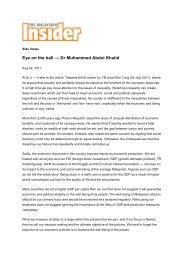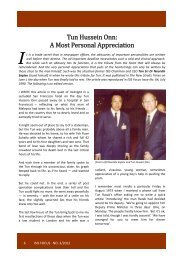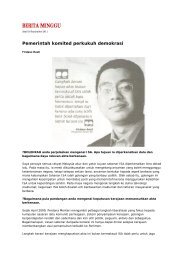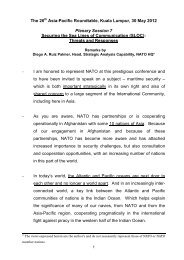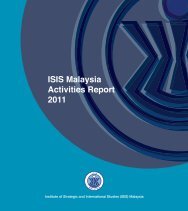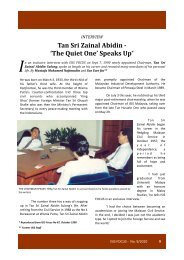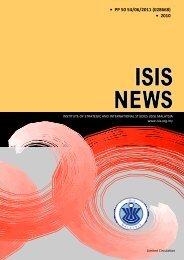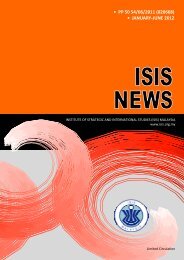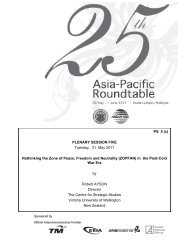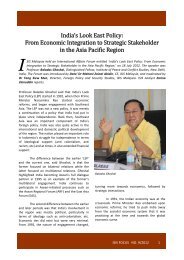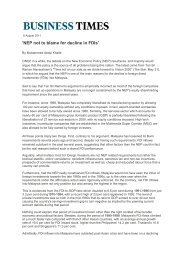Soft Power of Defence Diplomacy: A New Approach ... - ISIS Malaysia
Soft Power of Defence Diplomacy: A New Approach ... - ISIS Malaysia
Soft Power of Defence Diplomacy: A New Approach ... - ISIS Malaysia
You also want an ePaper? Increase the reach of your titles
YUMPU automatically turns print PDFs into web optimized ePapers that Google loves.
8For this reason, public diplomacy is too important to be left entirely to civilianagencies, since the actions <strong>of</strong> the US military affect the way other countries and theircitizens view the US. The US military on occasions such as the 2004 tsunamiresponse has successfully undertaken s<strong>of</strong>t power operations. Also, the US military’sshare <strong>of</strong> Official Development Aid (government assistance for the economies andwelfare <strong>of</strong> developing countries) increased from 3.5% in 1998 to 22% in 2005.USAID’s share declined from 65% to 40% in the same period. 25The rise <strong>of</strong> defence diplomacy is due to 3 insights derived from the Global War onTerrorism. First, from Iraq to Afghanistan, the fragile peace that was achievedthrough military force is not sustainable without a tangible peace dividend alongside arobust stabilization effort linked to long term, sustainable development. Second,fragile states with poor economy and weak governments was unable to protect ordefend their borders without providing essential services to and securing theallegiance <strong>of</strong> their citizens living in the vast ungoverned spaces most vulnerable toterrorist infiltration. Third, only the military has the personnel and operationalcapacity to fill in the vacuum in areas traditionally under the jurisdiction <strong>of</strong> civilianagencies. 26This resulted in the US Department <strong>of</strong> <strong>Defence</strong> (DoD) Directive 3000.05, issued inNovember 2005, which mandated the US military to treat stability operations as acore mission on par with combat operations. AFRICOM, a unified militaryheadquarters for Africa focusing on war prevention was launched in 2007 reflectingthis new emphasis but also take it further. It was designed to better enable civilmilitarycooperation to achieve a more stable environment in which political andeconomic growth can take place. Therefore, AFRICOM was given a developmentmandate and operates with an integrated interagency staff providing the platform forcoordination <strong>of</strong> other US government agencies. 27The AFRICOM model is spreading to other regional commands. In 2007, the USEuropean Command revised its Theatre Engagement Strategy, the document whichdetails methods on addressing threats to US national interests within the Europeantheatre. The new approach was called “Active Security” which emphasized nonmilitarytools to shape the strategic environment through a variety <strong>of</strong> civilianassistance missions, such as strengthening governance and improving health careinfrastructure. 28However, PACOM (Asia-Pacific region) have made no major modifications to theirorganizational structures to support the non-military humanitarian and civic assistancemission despite the mandate from DoD Directive 3000.05 and the substantial25 Williams, Abiodun, US Military and Public <strong>Diplomacy</strong>. Seib (ed), Toward a <strong>New</strong> Public <strong>Diplomacy</strong>:Redirecting US Foreign Policy. <strong>New</strong> York: Palgrave Macmillan, 2009.26 Smith, Gayle E., In Search <strong>of</strong> Sustainable Security: Linking National Security, Human Security andCollective Security to Protect America and Our World, Sustainable Security Series Paper. Center forAmerican Progress, 2008.27 Ibid.28 Brigety II, Reuben E., Humanity as a Weapon <strong>of</strong> War: Sustainable Security and the Role <strong>of</strong> the USMilitary, Sustainable Security Series Paper. Center for American Progress, 2008.




